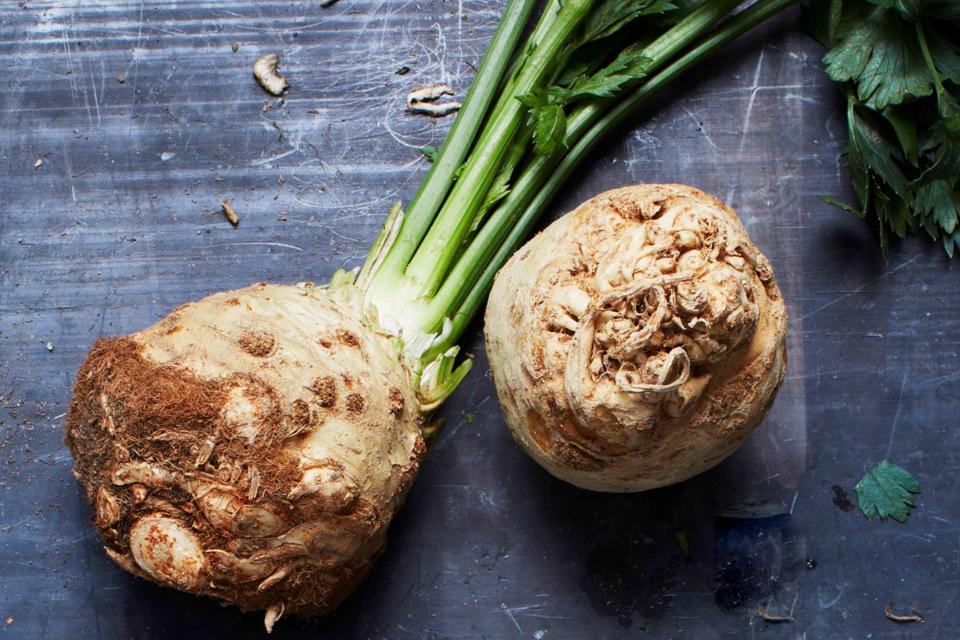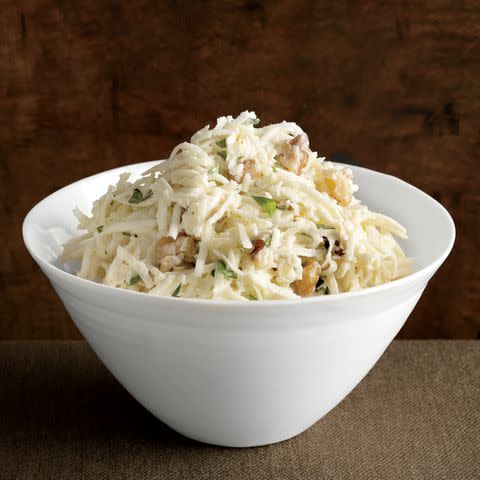Celeriac Is the Knobbly Root Vegetable You Should Be Using More Of
Learn how to embrace celery root, according to cooking teachers and produce experts, who are all big fans.

Marcus Nilsson
Celeriac, aka celery root, is having a moment—it's finally getting its time in the spotlight. Sales of celery root have grown 42 percent year over year, according to Baldor Specialty Foods’ Forecast for 2024, and the company expects to see that trend continue in 2024. So, what have you been missing out on by not using celeriac? We spoke to produce experts, growers, and cooking teachers to learn what makes celeriac so special and find out everything you should know about this rising star of the produce world, from how to store celeriac to how to use it in your cooking.
What Is Celeriac?
Celeriac is a large bulbous, bumpy, brownish root vegetable that is usually harvested in late fall and winter, says Donald Russo, senior category manager at Baldor Specialty Foods. It's long been very popular in various European cuisines, especially French, but only recently has celeriac started to take off stateside. Celeriac is incredibly versatile, and it is delicious cooked or raw, says Andrew Mumma, senior manager of culinary at meal-kit company Blue Apron.
It was originally cultivated in the Mediterranean Basin and in parts of Europe, Asia, and Africa. "Over the years, celeriac has spread throughout these continents and is now grown in North America as well," says Matt Hiltner, marketing coordinator, Babé Farms in Santa Maria, California, a family-owned grower of specialty vegetables.
Related: Celery Root Recipes
Taste
“Celeriac tastes like celery and parsnip blended together—with a hint of turnip,” says Emilie Berner, chef-instructor of plant-based culinary arts at the Institute of Culinary Education, adding that when celeriac is cooked, it mellows out and is sweeter.
Why Celeriac Isn't Better Known
Berner calls celeriac "an often under-appreciated root vegetable," noting that it's ranked somewhere below parsnip in popularity but probably above rutabaga. She thinks part of the problem is that it's considered ugly, and working with it can seem challenging (but it isn’t!).
Hiltner agrees that its form may impact why celeriac isn’t as commonplace as other vegetables. "Because of its rough exterior, celery root can intimidate consumers," Hiltner says. "Folks often tell me that they've seen it before but had no idea what it is or how to use it."

Celeriac vs. Celery
How celery root is different from celery is a question Hiltner often gets asked. They are essentially the same plant (Apium graveolens), but different varieties of this plant were cultivated to favor either the stalk or the root, he says. "The stalk variety (dulce) is the traditional celery you'd find at any retailer while the root variety (rapaceum) produces the bulbous head of snaggly rootlets we know as celery root," he says
Celeriac and celery have similar flavor profiles, but celery root has an added earthiness not found in celery.
"The fact that their textures and shapes are so different from each other means that they cannot necessarily be used interchangeably," he says. Where they can be swapped for each other is in soups, braises, and slow-cooked dishes says Mumma.
Related: The Right Way to Store Celery So It Stays Fresh and Crisp
Buying and Storing Celeriac
When shopping for celeriac, Hiltner says to choose ones that feel dense and heavy with no soft spots on the outside. "Look for crisp green stalks, and don't be scared of a little dirt or the aforementioned 'snaggly rootlets,'" he says—these will be removed when you peel and prep the vegetable.
Berner agrees, saying that when she selects celeriac, she follows the adage, "the dirtier, the better," because the dirt keeps things fresh. She reminds us that vegetables used to be stored in root cellars, neither washed, brushed, nor shaken.
Storage
If you're not going to use your celery root right away, Berner recommends storing it in a cool, dark place or in the crisper drawer of your refrigerator or, you know, your root cellar. Celeriac can be stored at room temperature in a cool, dark place for two weeks or in the refrigerator for up to three weeks, says Mumma.
Should you prep celeriac before storing it? Our experts say no, it's best to store celeriac whole until you plan to use it to maintain freshness. "Wrap it in a paper towel to keep it from drying out, then place it in a plastic bag and store in your fridge,” says Hiltner.
How to Prep Celeriac
Ready to turn that knobby goodness into your next great dish? Here’s how Berner recommends you prep celeriac. She says to start with a firm celery root, pockmarks are fine, they will be removed in the prep.
Slice off one end of the celeriac using a sharp chef's knife, so it sits flat on the chopping board.
Use a vegetable peeler to remove the skin and cut away the dirt and roots until you are left with a creamy white ball.
Wash the celeriac. (Our experts say there is no point in washing celeriac before you peel it.)
How to Use Celeriac

Celeriac is versatile. “It can be shaved and eaten raw, roasted, or slow-cooked for braises and soups,” says Mumma.
Celery root “is great diced small when making a mirepoix or sofrito,” says Mumma. “It also makes a delicious soup when cooked down with leeks and garlic in butter and puréed smooth with some heavy cream,” he says.
Raw
There's no need to cook celeriac to coax delectable flavor out of this root vegetable.
"Raw applications are quite common for celery root. It may be grated, matchstick cut, shaved, or diced and added to salads or slaws," says Hiltner. “The classic French celery root rémoulade features matchstick cut celery root tossed in a creamy, tangy Dijon dressing."
Another common pairing is celery root and apples. The two foods have similar textures and complementary flavors; "Maili Halme, a local chef in our area, makes an unbelievable salad with celery root, fennel, and apples with an apple cider vinaigrette," says Hiltner.
Cooked
Celeriac is often used in soups and stews, and those are Berner’s favorite ways to use the root veg. It also is a great swap for potatoes for anyone looking for a keto-friendly vegetable, says Hiltner
It’s also fabulous roasted, says Berner.
Celery root purée is quite popular at fine dining restaurants, says Hiltner. It's often served as a "silky, creamy bed for steak, fish, chicken, etc."
As you may have guessed, celery root purée has some similarities with mashed potatoes (you can even combine potatoes with celeriac to create a hybrid dish). Russo likes simply boiling cubed celeriac in vegetable broth until tender and mashing it like potatoes.
Take your stuffing to the next level by adding diced celery root.
Try celery root cottage pie, swapping the mashed potato topping for mashed celery root, says Hiltner.
Baked celery root chips are a favorite for Hiltner. He slices the celeriac thinly on a mandolin, tosses the chips with olive oil, salt, and pepper, and bakes them until golden and crisp!” Serve these chips with your choice of sauce.
A similar preparation is Russo's favorite—celeriac fries, which he says everyone loves. Cut the celeriac into strips, toss with olive oil, and bake.
Roasted and Sautéed
Mumma's favorite method of cooking celeriac is roasting it whole before cutting and sautéeing. It is a little time-consuming, he says, but the root roasts in the oven and yields an excellent result:
Preheat oven to 350°F.
Wash but do not peel a whole celery root.
Rub with olive oil and season with coarse salt.
Wrap in foil and roast for around two hours until tender. (Cook time will depend on size).
Let cool and peel.
Cut into 1-inch slices and sauté in browned butter for 2-3 minutes per side.
Dress with vinegar and chopped roasted nuts for serving.
Mumma says this preparation of celeriac can also be shaved and cut into thin strips and dressed with a mayonnaise-mustard dressing to make a slaw.
Read the original article on Martha Stewart.

